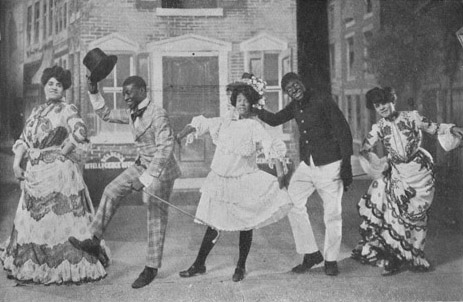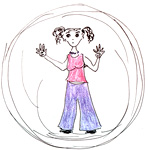
December 14, 2006
hot and cool
Posted by dogpossum on December 14, 2006 12:22 PM in the category lindy hop and other dances and music
I can't find the clip that I was looking for, but this is one of Snake Hips Tucker. This dood was reknown for... well, watch and you'll see.
But he's an interesting example of something Tommy DeFrantz describes in terms of a contrast between a 'cool' face and 'hot' body. For most of that clip Tucker's face is impassive. But his body is doing some crazy arse shit. I do have a bunch of other references on exactly this topic, but I haven't found them yet (I'm suspecting someone like Katrina Hazzard Gordon or Brenda Dixon Gottschild).

I've wondered if the aesthetic of 'cool' was in part a response to the conditions of slavery. As DeFrantz noted (and i paraphrase from memory), serious dancing went underground to avoid persecution under slavery, and the black man's body became a site of multiple layers of meaning, and unravelling each depended on the observer's knowledge.
Or, in a far nicer example,
In 1901, a former slave told the actor Leigh Whipper: "Us slaves watched white folks' parties where the guests danced a minuet and then paraded in a grand march, with the ladies and gentlemen going different ways and then meeting again, arm in arm, and marching down the center together. Then we'd do it too, but we used to mock 'em every step. Sometimes the white folks noticed it, but they seemed to like it; I guess they thought we couldn't dance any better" (Malone 18).
 Sounds a lot like cake walk to me. And of course, there is a long history of derision in African dance. Sometimes immitation is not the highest form of flattery. I know that it's certainly proved a valuable discursive tool for me in the past.
Sounds a lot like cake walk to me. And of course, there is a long history of derision in African dance. Sometimes immitation is not the highest form of flattery. I know that it's certainly proved a valuable discursive tool for me in the past.
So there were tactical reasons for maintaining a straight or 'cool' face while dancing.
But Malone extends her discussion of cool in African dance, noting
Personal coolness is an important hallmark of good style. Thompson has coined this phrase for such a set of values and attitudes: "an aesthetic of the cool." Coolness in this context has to do with control, transcendental balance, and directing one's energy with a clear purpose in mind. Thompson has identified this concept in the languages of thirty-five western and central African cultures. The Gola of Liberia define coolness in this way: "Ability to be nonchalant at hte right moment... to reveal no emotion in situations where excitement and sentimentality are acceptable - in other words, to act as though one's mind were in another world. It is particularly admirable to do difficult tasks with an air of ease silent disdain. Women are admired for a surly detached expression, and somnambulistic movement and attitude during the dance or other performance is considered very attractive." Thus, coolness is a metaphor for right living and diplomacy; it is "an all-embracing positive attribute which combines notions of composure, silence, vitality, healing, and social purification" (Malone 18-19)She also notes that
The canons of good behaviour insist that dancers become completely engrossed in what they are doing and avoid "throwing glances" at the audiences" (Malone 19).a point which resonates with me in the context of Melbourne swing. There's nothing more painful than a cheesy smile for or point at the audience - it's nasty to watch. Though in perfect accordance with the norm of competitive ballroom dance (check out Dancing with the Stars for a perfect example of not-cool).
And to bring it all back to lindy hop, there is nothing 'cooler' than the flat-out, parallel to the ground 'flying' style of Frankie Manning, where his body is long and lean and relaxed, but his legs and feet are going a million miles an hour. The ultimate cool/hot contrast. And it is the contrast that means so much.
So, if we think about this stuff in the context of Kate's questions about hot, cool and va-va-voom...
Perhaps it is that there's the contrast between the 'hot' body of the sensual woman (whether she is generously proportioned, tall and thin or whatever) and her 'cool' attitude of disdain. So Bessie Smith's sporting a decidedly 'hot' (or hawt?) body, but she is 'cool' in her control, her vocal ability. Hot in her statements of interest in sex, cool in her vocal delivery and timing.
...?
Oh, look here's an example. If you watch that solo blues clip (the one I've put in this post), you see some seriously hawt/hot bodily action (the whole 'lick your thumb then touch your hip in a 'sizzle' to test your own heat is a perfect illustration). But they're also sporting some serious cool snub. These chicks are really working it, but they are solidly unattainable. It's solo dancing. No one gets to touch them but them. And they certainly don't waste their time making eye contact with undesirables.
I'm not sure I've convinced myself with all that... Any one got any other thoughts?
References:
DeFrantz, Thomas. "The Black Male Body in Concert Dance." Moving Words: Re-Writing Dance. Ed. Gay Morris. London and New York: Routledge, 1996. 107 - 20.
---. “Believe the Hype!: Hype Williams and Afro-Futurist Filmmaking.†Unpublished paper. Spectacle, Rhythm and Eschatology: A Symposium. University of Melbourne, Melbourne, 24th July 2003.
---, ed. Dancing Many Drums: Excavations in African American Dance. Wisconsin: University of Wisconsin Press, 2003.
Gottschild, Brenda Dixon. Digging the Africanist Presence in American Performance. Connecticut and London: Greenwood Press, 1996.
---. "Stripping the Emperor: The Africanist Presence in American Concert Dance." Looking Out: Perspectives on Dance and Criticism in a Multicultural World. Eds. David Gere, et al. New York: Schirmer Books, 1995. 95 - 121.
Hazzard-Gordon, Katrina. "African-American Vernacular Dance: Core Culture and Meaning Operatives." Journal of Black Studies 15.4 (1985): 427-45.
---. Jookin': The Rise of Social Dance Formations in African-American Culture. Philadelphia: Temple University Press, 1990.
Malone, Jacqui. Steppin' on the Blues: The Visible Rhythms of African American Dance. Urbana and Chicago: University of Illinois Press, 1996.
Sorry, I can't find the full reference for the Thompson quite in Malone. :(
[edit]I just had to add this clip, which DustForEyes pointed out in his comments. Son of Snake Hips? Cool/hot much?




